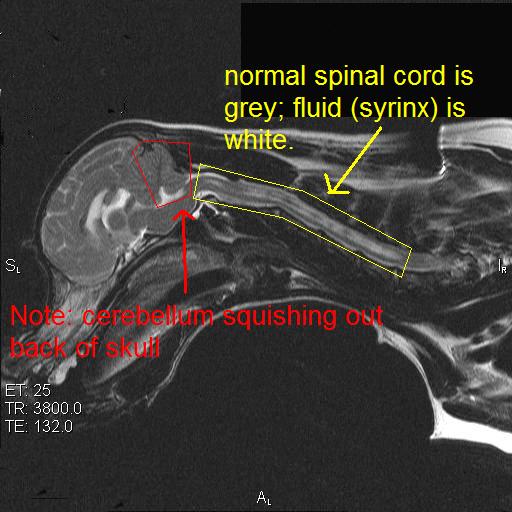Laurie's Blogs.
Jan 2021
Sensory Integration and Syringomyelia – An Accidental Finding

I made an interesting finding the other day with one of my patients. The dog has Chiari malformation / syringomyelia (CMSM), and occasionally has ‘fits’ where she gets low, goes into a scratching pattern, and cries. Since there’s not much (other than medication) that traditional veterinary medicine can do, the owner is interested in anything that we can provide from a physiotherapy perspective.
To date she has been receiving craniosacral therapy. This seems to have some positive effects. We have also used alpha-stim ear clips to provide cranial electrical stimulation, which also seems to have some positive effects. By ‘positive effects’, I mean we are monitoring how long the dog will go between ‘fits’.
She was in on Saturday and the owner had said that she had done very well since her last treatment in November (about 1.5 months ago) until just that week, when she had little ‘fits’ every day since then.
What did I do on the last treatment? Craniosacral to the head and neck; Craniosacral / Fascial unwinding via the tail; Laser to the skull (2 J/cm2, multiple points using a Spectravet Superpulsed multiprobe); and treatment was conducted on a Respond PEMF mat. Okay, so that treatment seemed to have made an improvement.
This past Saturday’s appointment, I found the dog to also have a sacroiliac joint dysfunction, and she was more restless as well. I mobilized the SIJ, which caused her to ‘squeak’ briefly, but unfortunately, it unsettled her a bit more, as did a barking dog outside the door. I managed to laser her head, do 12 minutes of alpha stim, and was trying to do craniosacral therapy (which she was almost too wiggly for), when she went into one of her ‘fits’.
Here’s what I noticed during her ‘fit’. She could not tolerate pressure of any kind (i.e. craniosacral) over her occiput. She could tolerate touch on C1, but it didn’t improve her reaction. What did improve the reaction was a full body squeeze (like I discuss in my Video Trainings 136 & 137 on Sensory Integration). So, I did the full body squeezes until she settled. Interestingly, when she started into the ‘fit’, it would worsen when the dog barked outside the door, just as it did when I touched the occiput. Soooo, here’s a summation of my accidental findings and guess on correlation.
1. The thought is that the CMSM creates pressure that causes abnormal sensations (pain and/or itchiness).
2. So touching the occiput during a ’fit’ would likely exacerbate the unpleasant sensation.
3. The CMSM ‘fit’ seems to have made this little dog extra sensitive to touch and sound.
4. Firm pressure / squeezing seemed to minimize the ‘fit’ – as it would with a ‘sensory defensive’ individual.
5. Craniosacral therapy has been shown to have an effect on the autonomic nervous system (which may have helped to allow the longer stretch of time between treatments).
6. Lasering the brain has been shown to help with brain traumas (See Training Video 181), which is my goal with using it here.
So, my next plan is to trial sensory integration treatment techniques on this little dog and prescribe them for home management to see if, 1) the owner can quickly stop any ‘fits’ that occur, and 2) we can extend the time needed between treatment sessions. All in all, it’s a fascinating case! Chiari malformation / Syringomyelia may have a sensory integration component, and seems to respond to sensory integration techniques, craniosacral therapy, laser, and cranial electrical stimulation. Indeed, I realized that this is all just clinical hearsay… but isn’t this how great discoveries are made? I’d also encourage any of you with CMSM cases, to give some of this a try (and let me know YOUR findings too)!
Until next time… Cheers!
Laurie


